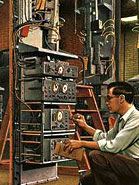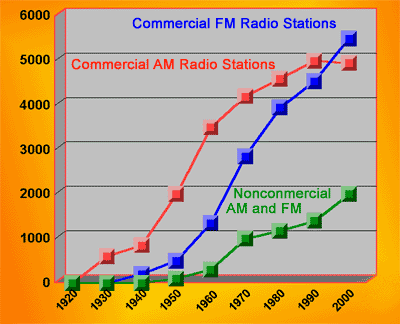Film, Radio and TV - 20 |

The Dawn of
The story of FM radio is one of success and tragedy. In the mid-30s, Major Edwin Armstrong, an inventor who had already devised a successful circuit to improve AM radio, came up with a whole new approach to transmitting radio signals. Armstrong was clearly a technical genius, and is still considered the most prolific inventor in radio's history. Even though he had improved AM radio in significant ways, Armstrong was well aware of AM radio's major limitations:
Armstrong's new approach to encoding audio for transmission eliminated these problems. Recall that in Module 17 we explained the technical differences between the AM and FM systems of transmission. Armstrong took his invention to a friend, David Sarnof, who was head of RCA. Sarnof had promised that he would help him develop it. RCA bought into the patents and helped Armstrong develop an experimental radio station. But, as it developed, Sarnof and RCA were out to protect their AM radio empire and thwarted the development of FM radio through their claim on Armstrong's patents. Years of costly legal battles ensued that RCA could afford and Armstrong couldn't. Among other things, they soon decided to close down the FM station that they had originally helped Armstrong build. |
By 1941, 50 FM stations were on the air. Then the Japanese bombed Pearl Harbor. The ensuing war diverted resources and froze development. David Sarnof and RCA, still out to hold control of their radio empire, pressured the FCC to change all of the FM radio frequencies--a move they knew would instantly obsolete all of the exiting FM radios, and cause Armstrong to lose his personal investment in FM radio. Listeners were understandably upset at having their radios suddenly rendered useless. And, having been "burned once," they were reluctant to immediately go out and buy new FM radios. Since most radio station owners didn't want to go to the expense of creating high-fidelity programming just for their FM stations, the FCC allowed them to simulcast--simultaneously broadcast the same programming on both their AM and FM stations. Of course, this didn't show off FM's quality advantages, and it did nothing to help the cause of FM. (Years later, the FCC ruled against the practice of simulcasting.) Once TV started to evolve (to be covered in an upcoming module), interest in FM radio further diminished, and by 1949, many FM stations had shut down. Although Armstrong tried to fight for his superior radio system, RCA continued to tie him up with court battles. These both sapped his creative energies and drained his financial resources. On January 31, 1954, Edwin Armstrong, gave up his long, taxing battle against Sarnof and RCA. He wrote a note to his wife apologizing for what he was about to do, removed the air conditioner from his 13th story New York apartment, and jumped to his death. A few weeks later RCA announced record profits. Unfortunately, Armstrong never lived to see the great success of his invention. Nor will we know what other inventions this genius of electronics might have contributed if his personal and financial resources hadn't been devastated by years of legal battles. Interestingly, once FM radio started to make money, RCA quickly started pushing its development and subsequently made millions of dollars from the sale of FM transmitters and equipment. As you can see from the graph below, FM radio not only climbed out of the cellar of popularity after Armstrong's death, but today it leads AM radio in both number of stations and listeners. The green line represents the growth of noncommercial and National Public Radio (NPR) stations. We'll cover public broadcasting--both radio and television--in an upcoming module.
In the next module we'll take up a form of radio that few North Americans know much about, but one that has often influenced the course of world history, and has been the arena for multi-billion dollar "wars of the air waves." |
To next module
To index © 1996 - 2005, All Rights Reserved.
|
 sold rights to manufacture FM radios to several companies.
sold rights to manufacture FM radios to several companies.